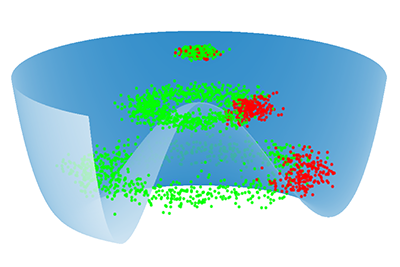Uncovering the Symmetries of Quantum Matter Far From Equilibrium
| Project Manager | Dr. Aleksandr Mikheev, Dr. Viktoria Noel |
|---|---|
| Principal Investigator | Prof. Dr. Jürgen Berges, Prof. Dr. Markus Oberthaler |
| Author of this Article | Dr. Viktoria Noel |
| Affiliation | University of Heidelberg, Institute for Theoretical Physics, and Kirchhoff Institute for Physics |
| Project duration | 06/2023 - 08/2024 |
| Platform used | bwUniCluster 2.0, bwForCluster JUSTUS |
| bwHPC Domain | Quantum Physics |
| DOI of Publication | 10.21468/SciPostPhys.18.2.044 |
| Project added | 03.11.2025 |
One of the most powerful ideas in physics is that of symmetry—the notion that certain properties of a system remain unchanged under specific transformations, like rotations or reflections. When physical systems are in a balanced, equilibrium state, symmetries already determine much of their behaviour, linking microscopic laws to the macroscopic patterns we observe. However, much less is known about what happens when a quantum system is far away from this balanced state. To address this question, we have developed a framework for identifying the hidden or emergent symmetries that arise in nonequilibrium conditions, and tested it with experimental data from a quantum simulator.
Specifically, we studied the phenomenon of spontaneous symmetry breaking, where systems that start with no preferred direction end up “choosing” one. This is just like a ball rolling down a hill into a valley, picking one side to settle in, even though the hill was perfectly symmetrical, as shown in Figure 1. However, in a quantum simulation experiment, due to the inherently probabilistic nature of quantum mechanics, a single measurement does not tell the full story. Instead, one needs to repeat the experiment many times under identical conditions and then analyse the resulting distribution of outcomes. For the case of ultracold atomic clouds, instead of a ball rolling down a hill, each experiment yields one realisation of the system’s evolution, as seen in Figure 2. The red blob of ultracold atoms highlights a single such instance, where the system spontaneously selects a direction, breaking the symmetry in that particular experimental run. When we repeat the experiment many times, the outcomes on average form a ring-shaped pattern (shown in green colour), which conceals the spontaneously broken symmetry.
Our research provides a framework to uncover and quantify this spontaneously broken symmetry via so-called correlation functions, which describe how different parts of the system are connected to each other in space or time. They capture how a change at one point influences another, revealing collective patterns that individual measurements cannot show. Computing these correlations requires analysing large datasets, which is a very memory-intensive procedure. Using the bwHPC high-performance computing infrastructure we were able to perform large-scale simulations and data analyses.
Overall, our results demonstrate the extraction of effective symmetries directly from experimental and numerically simulated data. This is important for developing predictive theories of nonequilibrium quantum dynamics and it paves the way for future investigations into complex systems ranging from ultracold atoms to early-universe models.


